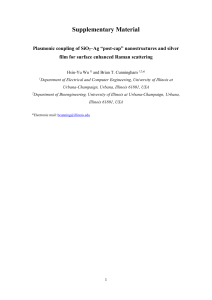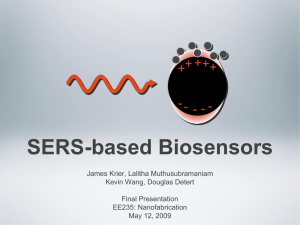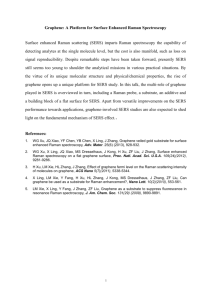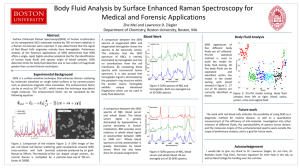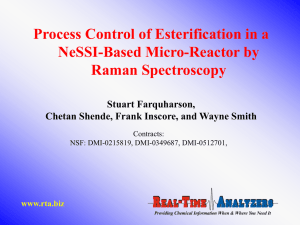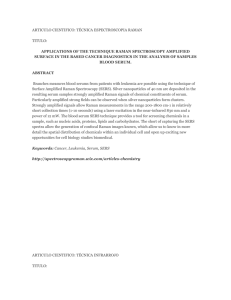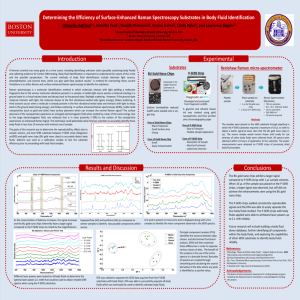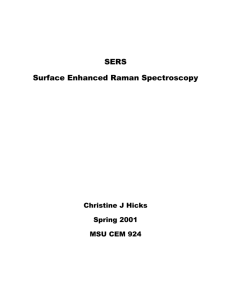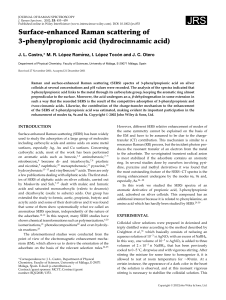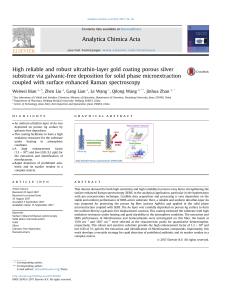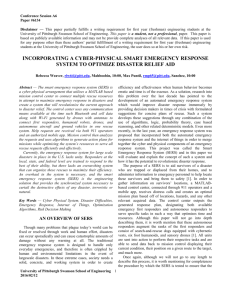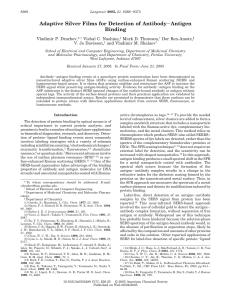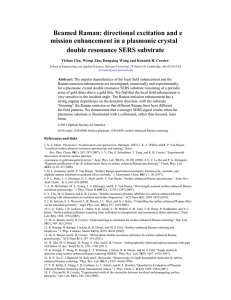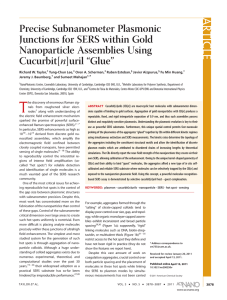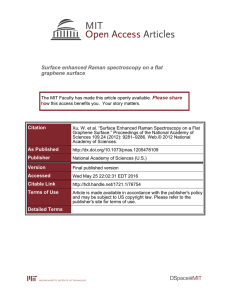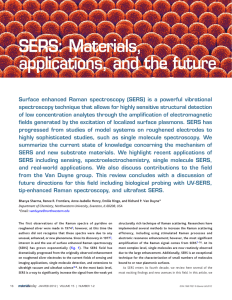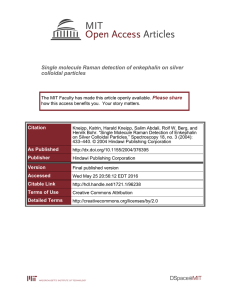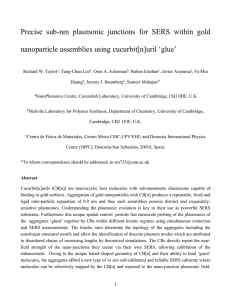A SERS study of charge-transfer processes in the
advertisement
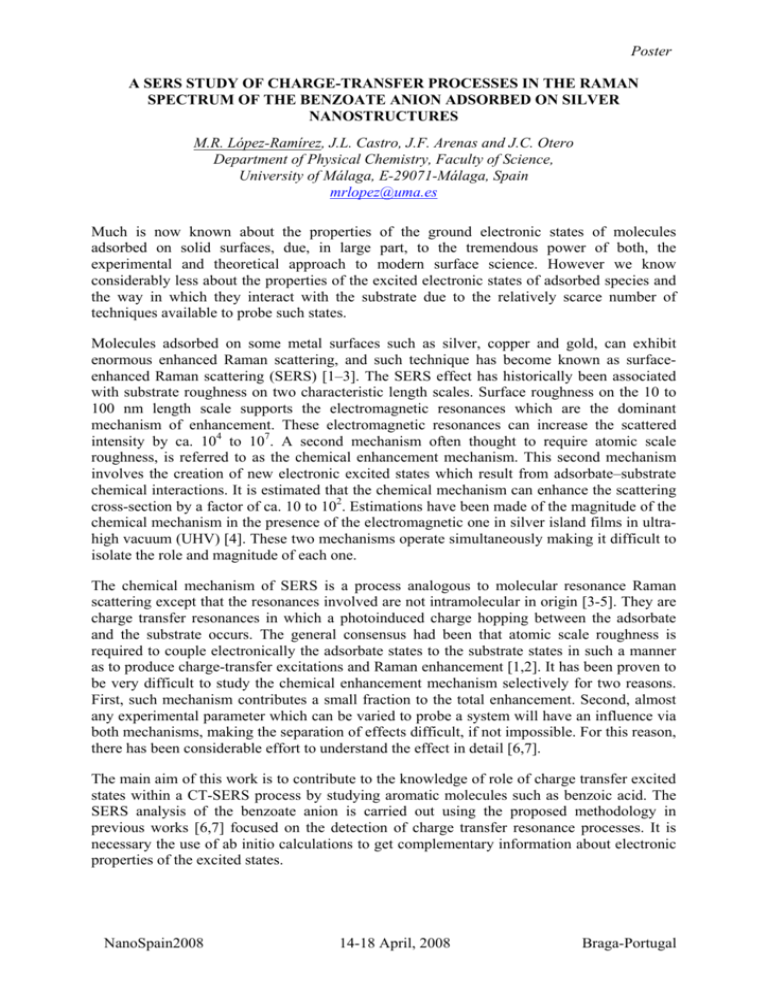
Poster A SERS STUDY OF CHARGE-TRANSFER PROCESSES IN THE RAMAN SPECTRUM OF THE BENZOATE ANION ADSORBED ON SILVER NANOSTRUCTURES M.R. López-Ramírez, J.L. Castro, J.F. Arenas and J.C. Otero Department of Physical Chemistry, Faculty of Science, University of Málaga, E-29071-Málaga, Spain mrlopez@uma.es Much is now known about the properties of the ground electronic states of molecules adsorbed on solid surfaces, due, in large part, to the tremendous power of both, the experimental and theoretical approach to modern surface science. However we know considerably less about the properties of the excited electronic states of adsorbed species and the way in which they interact with the substrate due to the relatively scarce number of techniques available to probe such states. Molecules adsorbed on some metal surfaces such as silver, copper and gold, can exhibit enormous enhanced Raman scattering, and such technique has become known as surfaceenhanced Raman scattering (SERS) [1–3]. The SERS effect has historically been associated with substrate roughness on two characteristic length scales. Surface roughness on the 10 to 100 nm length scale supports the electromagnetic resonances which are the dominant mechanism of enhancement. These electromagnetic resonances can increase the scattered intensity by ca. 104 to 107. A second mechanism often thought to require atomic scale roughness, is referred to as the chemical enhancement mechanism. This second mechanism involves the creation of new electronic excited states which result from adsorbate–substrate chemical interactions. It is estimated that the chemical mechanism can enhance the scattering cross-section by a factor of ca. 10 to 102. Estimations have been made of the magnitude of the chemical mechanism in the presence of the electromagnetic one in silver island films in ultrahigh vacuum (UHV) [4]. These two mechanisms operate simultaneously making it difficult to isolate the role and magnitude of each one. The chemical mechanism of SERS is a process analogous to molecular resonance Raman scattering except that the resonances involved are not intramolecular in origin [3-5]. They are charge transfer resonances in which a photoinduced charge hopping between the adsorbate and the substrate occurs. The general consensus had been that atomic scale roughness is required to couple electronically the adsorbate states to the substrate states in such a manner as to produce charge-transfer excitations and Raman enhancement [1,2]. It has been proven to be very difficult to study the chemical enhancement mechanism selectively for two reasons. First, such mechanism contributes a small fraction to the total enhancement. Second, almost any experimental parameter which can be varied to probe a system will have an influence via both mechanisms, making the separation of effects difficult, if not impossible. For this reason, there has been considerable effort to understand the effect in detail [6,7]. The main aim of this work is to contribute to the knowledge of role of charge transfer excited states within a CT-SERS process by studying aromatic molecules such as benzoic acid. The SERS analysis of the benzoate anion is carried out using the proposed methodology in previous works [6,7] focused on the detection of charge transfer resonance processes. It is necessary the use of ab initio calculations to get complementary information about electronic properties of the excited states. NanoSpain2008 14-18 April, 2008 Braga-Portugal Poster The analysis of the SERS spectra of benzoate anion on the basis of the CT mechanism takes account for the experimental evidences. It is able to explain not only the enhancement of several SERS bands but also why some specific modes are the strongest ones at negative electrode potentials. In addition, we have been able to extract information on the two lowest CT excited electronic states which are very close in energy as happens in the radical anions of aromatic molecules similar to benzene. References: [1] M. Moskovits, Rev. Mod. Phys. 57 (1985) 783. [2] B. Pettinger, in: J. Lipkowski, P.N. Ross (Eds.), Adsorption of Molecules at Metal Electrodes, VCH, New York, 1992, p. 285. [3] A. Campion, P. Kambhampati, Chem. Soc. Rev. 27 (1998) 241. [4] I. Mrozek, A. Otto, J. Electron Spectrosc. Relat. Phenom. 54 (1990) 895. [5] J.R. Lombardi, R.L. Birke, T. Lu, J. Xu, J. Chem. Phys. 84 (1986) 4174. [6] J.F. Arenas, I. Lopez Tocon, J.C. Otero, J.I. Marcos, J. Phys. Chem. 100 (1996) 9254. [7] J.F. Arenas, M.S.Wooley, J.C. Otero, J.I. Marcos, J. Phys. Chem. 100 (1996) 3199. Figures: 12 -0.75 V 8a 8a 19a Relative Intensity Relative Intensity ν(CX) 1 - νs(CO2 ) -0.50 V -0.25 V - νs(CO2 ) 0.00 V 1 18a / ν(CX) Solution 1M 19a 0 200 400 600 800 1000 1200 1400 1600 1800 -1 Δν / cm 0.00 -0.25 -0.50 Electrode Potential / V -0.75 (I) (II) Figure 1. (I) Raman spectra of an aqueous solution and SERS of sodium benzoate on recorded silver at different electrode potential. (II) Relative intensities of the strongest bands recorded in the SERS of sodium benzoate referred to that of mode 2; ν (CH). Acknowledgements: This research has been supported by the Spanish Ministerio de Educación y Ciencia (Project Number NAN200409312-C03 and CTQ2006-02330) and Junta de Andalucía (Project Number FQM-01895). NanoSpain2008 14-18 April, 2008 Braga-Portugal
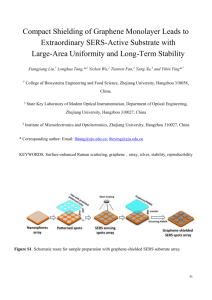
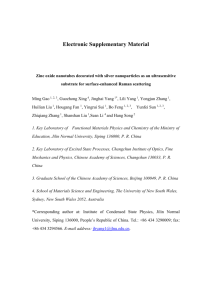
![[1] M. Fleischmann, P.J. Hendra, A.J. McQuillan, Chem. Phy. Lett. 26](http://s3.studylib.net/store/data/005884231_1-c0a3447ecba2eee2a6ded029e33997e8-300x300.png)
